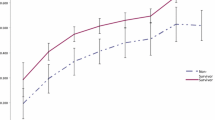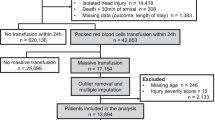Abstract
Purpose
High ratios of Plasma to Packed Red Blood Cells (FFP:PRBC) improve survival in massively transfused trauma patients. We hypothesized that non-trauma patients also benefit from this transfusion strategy.
Methods
Non-trauma patients requiring massive transfusion from November 2003 to September 2011 were reviewed. Logistic regression was performed to identify independent predictors of mortality. The population was stratified using two FFP:PRBC ratio cut-offs (1:2 and 1:3) and adjusted mortality derived.
Results
Over 8 years, 29 % (260/908) of massively transfused surgical patients were non-trauma patients. Mortality decreased with increasing FFP:PRBC ratios (45 % for ratio ≤1:8, 33 % for ratio >1:8 and ≤1:3, 27 % for ratio >1:3 and ≤1:2 and 25 % for ratio >1:2). Increasing FFP:PRBC ratio independently predicted survival (AOR [95 % CI]: 1.91 [1.35–2.71]; p < 0.001). Patients achieving a ratio >1:3 had improved survival (AOR [95 % CI]: 3.24 [1.24–8.47]; p = 0.016).
Conclusion
In non-trauma patients undergoing massive transfusion, increasing FFP:PRBC ratio was associated with improved survival. A ratio >1:3 significantly improved survival probability.


Similar content being viewed by others
References
Gonzalez EA, Moore FA, Holcomb JB, Miller CC, Kozar RA, Todd SR, et al. Fresh frozen plasma should be given earlier to patients requiring massive transfusion. J Trauma Acute Care Surg. 2007;62(1):112–9.
Borgman MA, Spinella PC, Perkins JG, Grathwohl KW, Repine T, Beekley AC, et al. The ratio of blood products transfused affects mortality in patients receiving massive transfusions at a combat support hospital. J Trauma Acute Care Surg. 2007;63(4):805–13.
Teixeira PGR, Inaba K, Shulman I, Salim A, Demetriades D, Brown C, et al. Impact of plasma transfusion in massively transfused trauma patients. J Trauma Acute Care Surg. 2009;66(3):693–7.
Maegele M, Lefering R, Paffrath T, Tjardes T, Simanski C, Bouillon B, et al. Red-blood-cell to plasma ratios transfused during massive transfusion are associated with mortality in severe multiple injury: a retrospective analysis from the Trauma Registry of the Deutsche Gesellschaft für Unfallchirurgie. Vox Sang. 2008;95(2):112–9.
Holcomb JB, Wade CE, Michalek JE, Chisholm GB, Zarzabal LA, Schreiber MA, et al. Increased plasma and platelet to red blood cell ratios improves outcome in 466 massively transfused civilian trauma patients. Ann Surg. 2008;248(3):447–58.
Duchesne JC, Islam TM, Stuke L, Timmer JR, Barbeau JM, Marr AB, et al. Hemostatic resuscitation during surgery improves survival in patients with traumatic-induced coagulopathy. J Trauma Acute Care Surg. 2009;67(1):33–7–discussion37–9.
Gunter OL, Au BK, Isbell JM, Mowery NT, Young PP, Cotton BA. Optimizing outcomes in damage control resuscitation: identifying blood product ratios associated with improved survival. J Trauma Acute Care Surg. 2008;65(3):527–34.
Zink KA, Sambasivan CN, Holcomb JB, Chisholm G, Schreiber MA. A high ratio of plasma and platelets to packed red blood cells in the first 6 hours of massive transfusion improves outcomes in a large multicenter study. Am J Surg. 2009;197(5):565–70 (discussion 570).
Duchesne JC, Hunt JP, Wahl G, Marr AB, Wang Y-Z, Weintraub SE, et al. Review of current blood transfusions strategies in a mature level I trauma center: were we wrong for the last 60 years? J Trauma Acute Care Surg. 2008;65(2):272–6 (discussion 276–8).
Davenport R, Curry N, Manson J, De’Ath H, Coates A, Rourke C, et al. Hemostatic effects of fresh frozen plasma may be maximal at red cell ratios of 1:2. J Trauma Acute Care Surg. 2011;70(1):90–5 (discussion 95–6).
Shaz BH, Dente CJ, Nicholas J, MacLeod JB, Young AN, Easley K, et al. Increased number of coagulation products in relationship to red blood cell products transfused improves mortality in trauma patients. Transfusion. 2010;50(2):493–500.
Lier H, Böttiger BW, Hinkelbein J, Krep H, Bernhard M. Coagulation management in multiple trauma: a systematic review. Intensive Care Med. 2011;37(4):572–82.
Brown LM, Aro SO, Cohen MJ, Trauma Outcomes Group, Holcomb JB, Wade CE, et al. A high fresh frozen plasma: packed red blood cell transfusion ratio decreases mortality in all massively transfused trauma patients regardless of admission international normalized ratio. J Trauma Acute Care Surg. 2011;71(2 Suppl 3):S358–63.
Lustenberger T, Frischknecht A, Brüesch M, Keel MJB. Blood component ratios in massively transfused, blunt trauma patients—a time-dependent covariate analysis. J Trauma Acute Care Surg. 2011;71(5):1144–50 (discussion 1150–1).
Kautza BC, Cohen MJ, Cuschieri J, Minei JP, Brackenridge SC, Maier RV, et al. Changes in massive transfusion over time: an early shift in the right direction? J Trauma Acute Care Surg. 2012;72(1):106–11.
Brown JB, Cohen MJ, Minei JP, Maier RV, West MA, Billiar TR, et al. Debunking the survival bias myth: characterization of mortality during the initial 24 hours for patients requiring massive transfusion. J Trauma Acute Care Surg. 2012;73(2):358–64 (discussion 364).
Guidry C, Dellavope J, Simms E, Heaney JB, Guice J, McSwain N, et al. Impact of inverse ratios on patients with exsanguinating vascular injuries: should more be the new paradigm? J Trauma Acute Care Surg. 2013;74(2):403–9 (discussion 409–10).
Holcomb JB, Tilley BC, Baraniuk S, Fox EE, Wade CE, Podbielski JM, et al. Transfusion of plasma, platelets, and red blood cells in a 1:1:1 vs a 1:1:2 ratio and mortality in patients with severe trauma: the PROPPR randomized clinical trial. JAMA. 2015;313(5):471–82.
Magnotti LJ, Zarzaur BL, Fischer PE, Williams RF, Myers AL, Bradburn EH, et al. Improved survival after hemostatic resuscitation: does the emperor have no clothes? J Trauma Acute Care Surg. 2011;70(1):97–102.
Snyder CW, Weinberg JA, McGwin G, Melton SM, George RL, Reiff DA, et al. The relationship of blood product ratio to mortality: survival benefit or survival bias? J Trauma Acute Care Surg. 2009;66(2):358–62 (discussion 362–4).
Holcomb JB, del Junco DJ, Fox EE, Wade CE, Cohen MJ, Schreiber MA, et al. The prospective, observational, multicenter, major trauma transfusion (PROMMTT) study: comparative effectiveness of a time-varying treatment with competing risks. JAMA Surg. 2013;148(2):127–36.
Cohen MJ, West M. Acute traumatic coagulopathy: from endogenous acute coagulopathy to systemic acquired coagulopathy and back. J Trauma Acute Care Surg. 2011;70(5 Suppl):S47–9.
Neal MD, Hoffman MK, Cuschieri J, Minei JP, Maier RV, Harbrecht BG, et al. Crystalloid to packed red blood cell transfusion ratio in the massively transfused patient. J Trauma Acute Care Surg. 2012;72(4):892–8.
Brown JB, Cohen MJ, Minei JP, Maier RV, West MA, Billiar TR, et al. Goal-directed resuscitation in the prehospital setting. J Trauma Acute Care Surg. 2013;74(5):1207–14.
Repine TB, Perkins JG, Kauvar DS, Blackborne L. The use of fresh whole blood in massive transfusion. J Trauma Acute Care Surg. 2006;60(6 Suppl):S59–69.
Spinella PC, Perkins JG, Grathwohl KW, Beekley AC, Holcomb JB. Warm fresh whole blood is independently associated with improved survival for patients with combat-related traumatic injuries. J Trauma Acute Care Surg. 2009;66(4 Suppl):S69–76.
Nascimento B, Callum J, Tien H, Rubenfeld G, Pinto R, Lin Y, et al. Effect of a fixed-ratio (1:1:1) transfusion protocol versus laboratory-results-guided transfusion in patients with severe trauma: a randomized feasibility trial. CMAJ. 2013;185(12):E583–9.
Gonzalez E, Moore EE, Moore HB, Chapman MP, Chin TL, Ghasabyan A, et al. Goal-directed Hemostatic Resuscitation of Trauma-induced Coagulopathy: A Pragmatic Randomized Clinical Trial Comparing a Viscoelastic Assay to Conventional Coagulation Assays. Ann Surg. 2015 [Epub ahead of print].
Mell MW, O’Neil AS, Callcut RA, Acher CW, Hoch JR, Tefera G, et al. Effect of early plasma transfusion on mortality in patients with ruptured abdominal aortic aneurysm. Surgery. 2010;148(5):955–62.
Johansson PI, Stensballe J, Rosenberg I, Hilsløv TL, Jørgensen L, Secher NH. Proactive administration of platelets and plasma for patients with a ruptured abdominal aortic aneurysm: evaluating a change in transfusion practice. Transfusion. 2007;47(4):593–8.
Kauvar DS, Sarfati MR, Kraiss LW. Intraoperative blood product resuscitation and mortality in ruptured abdominal aortic aneurysm. J Vasc Surg. 2012;55(3):688–92.
Inaba K, Branco BC, Rhee P, Blackbourne LH, Holcomb JB, Teixeira PGR, et al. Impact of plasma transfusion in trauma patients who do not require massive transfusion. J Am Coll Surg. 2010;210(6):957–65.
Sambasivan CN, Kunio NR, Nair PV, Zink KA, Michalek JE, Holcomb JB, et al. High ratios of plasma and platelets to packed red blood cells do not affect mortality in nonmassively transfused patients. J Trauma Acute Care Surg. 2011;71(2 Suppl 3):S329–36.
Johnson JL. Effect of blood products transfusion on the development of postinjury multiple organ failure. Arch Surg. 2010;145(10):973–7.
Author information
Authors and Affiliations
Corresponding author
Ethics declarations
Conflict of interest statement
Pedro G. Teixeira, Kenji Inaba, Efstathios Karamanos, Peter Rhee, Ira Shulman, Dimitra Skiada, Konstantinos Chouliaras, Demetrios Demetriades declare that they have no conflict of interest.
Compliance with ethical requirements
This study received IRB approval and has been performed in accordance with the ethical standards defined in the 1964 Declaration of Helsinki and its later amendments.
Rights and permissions
About this article
Cite this article
Teixeira, P.G., Inaba, K., Karamanos, E. et al. The survival impact of plasma to red blood cell ratio in massively transfused non-trauma patients. Eur J Trauma Emerg Surg 43, 393–398 (2017). https://doi.org/10.1007/s00068-016-0674-5
Received:
Accepted:
Published:
Issue Date:
DOI: https://doi.org/10.1007/s00068-016-0674-5




